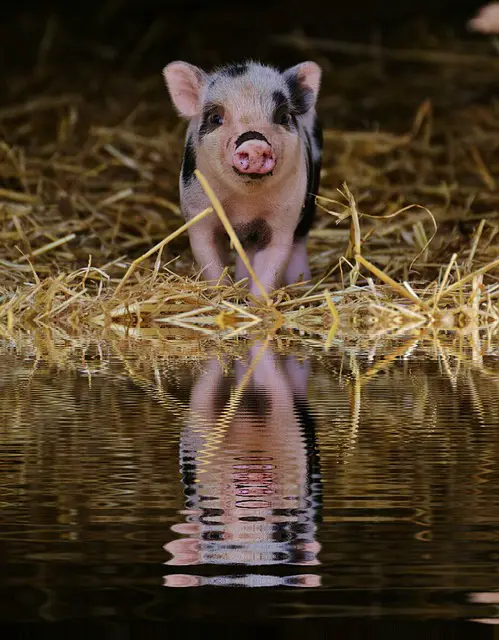Water is a crucial part of a mini pig’s diet and can affect its overall health.
Pigs require around 2 to 7 liters per day on average. This depends on the pig’s age, weight, and overall health.
As you read through this article, you’ll realize that lack of water won’t just lead to your pig getting thirsty. It may result to something even more serious, like sickness, and even death.

Recommended Water Intake for Pigs
A lot of pig owners forget that aside from the quality of food that they provide for their pets, water is another critical part of their diet.
The key to providing enough water for your pig lies in knowing how much it should be drinking at its age. Here’s a chart that shows how much water your pig should be drinking:
Type of Pig
Nursery (0 to 60 lbs)
Grower (60 to 100 lbs)
Finisher (100 to 250 lbs)
Gestating pigs
Lactating pigs
Recommended Water Intake
0.7 to 1 gallon
2 to 3 gallons
3 to 5 gallons
3 to 6 gallons
5 to 7 gallons
Note that a pig’s need for water may also be affected by different factors. For example, a pig that has become much more active than before would definitely need more water. Pigs with high metabolism lose more water by the minute, and this water loss would have to be recovered right away.
Hotter weather would also mean a need for more water. Just as humans are more thirsty during the summer, pigs are also more thirsty. Water helps your pig regulate its body temperature and keep it at optimal levels, and during the hot season, your pig loses more water than usual.
It’s also important to know that pigs do not have the same amount of sweat glands that humans do. In fact, the few sweat glands they have don’t even function well. This means that pigs are unable to cool themselves down through perspiration. So you’d really have to introduce more water into their system to help cool them off.
Your pig may also need more water when it gets sick, especially if it’s vomiting or has diarrhea. In some cases, your vet may require you to add electrolytes to your pig’s water to make sure its fluid levels remain balanced and healthy.
Read this article to find out more about electrolytes and its importance to your pig’s health.
What Happens When a Pig Doesn’t Drink Enough Water?
When a pig doesn’t drink as much as it needs, it is in danger of dehydration or salt poisoning, which can lead to more serious conditions.
How do you know if your pig is in danger of dehydration? Watch out for the following signs:
- Refuses to eat or drink
- Extremely low energy level
- Sullen and depressed
- Shaking or uncoordinated movements
- Possible convulsions
- Bloated
- Shallow or rapid breathing
- Constipation
- Less urine than normal
- Either lower or higher temperature than normal
This is why it is extremely important to keep track of your pig’s water intake. In case you notice any of the symptoms above persisting for 24 hours, then it’s time to call your vet.
To find out more about dehydration in pigs, check this article out.
What If My Pig Doesn’t Like Drinking Water?
Some experts claim that pigs, to some extent, actually prefer water more than mud. But why is it so hard to get some pigs to drink water? Does a pig’s love for water only extend to swimming, and not to drinking?
The truth is, there could be so many reasons why your pig is refusing to drink the right amount of water. Here are some tips that could help you get your pig to drink more:
- Get water from a different source.
Try giving them water from a different source. If you’re letting them drink water directly from a faucet, for example, try giving them bottled water or filtered water. If they drink that, then most probably, the problem is in the water that you usually give them.
Check the water source for possible rusting or for any breakage that could potentially be letting dirt seep into the water. You should check the temperature as well, especially if your pipelines are exposed. It may be too cold or too hot for your pig to drink.
- Add some flavor into their water.
If there seems to be nothing wrong with the water you’re giving them, try adding some flavor into the water. Just remember that too much sweetener (especially artificial sweeteners) are bad for your pig. So if you’re going to use juice, add as little as possible. Don’t worry, even the smallest amount of added flavor is more than enough.
As much as possible, look for something natural and with little to no artificial sweeteners in it to be one the safe side.
- Add edible treats.
Another great way to keep your pig interested in the water it’s drinking is adding some edible treats for it to find.
You can put in some of your pig’s favorite treats, like Cheerios or popcorn. This can ruin his diet a bit though, so don’t overdo it. Make adjustments as needed.
Even better, you can add vegetables and fruits that have high water content. Not only will these be healthier, they can also help in hydrating your pig better. Cucumbers and watermelons are great, but again, make sure you check this against your pig’s recommended diet and make adjustments whenever needed.
- Check their water bowl for contamination.
Pigs are really clean animals, despite having a reputation that says otherwise. And there’s a chance that they’re refusing to drink from their bowl simply because it’s dirty.
More than a dirty bowl adding a yucky taste to their water, water bowls that aren’t cleaned properly and regularly could have a layer of biofilm, which can lead to a lot of serious illnesses.
Biofilm is made up of different inorganic and organic stuff, with both dead and living materials and organisms all gathering in your pig’s bowl. Just run a finger across your pig’s bowl. If you feel anything slimy there, that’s got to be biofilm. Clean up your pig’s bowl as thoroughly as you can.
What If My Pig Drinks Too Much Water?
Yup, aside from the dilemma of having a pig that doesn’t drink, it’s also possible to have a pig that just wouldn’t stop drinking. This condition is called polydipsia.
What causes pigs to be unusually thirsty all the time?
- Boredom
- Kidney disease
- Diabetes mellitus and diabetes insipidus
- Liver disease
- Infection
- Imbalanced electrolytes
- Certain medications
If you feel like your pig is drinking too much water, consult your vet to get to the root of the problem. From here, it will be easier to find ways to maintain a healthier water intake.
Related Questions
How much should I feed my mini potbelly pig?
Your pig should eat half a cup of feed for every 25 lbs of its weight. This means that if your pig is 75 lbs, it should be eating a cup and a half of feed split into two servings per day. This recommended feed intake may also change depending on your pig’s condition. For example, a nursing sow would require more food intake because it has to recover the nutrients it loses as her piglets nurse from her.
How big can a mini pig get?
Mini pigs usually grow up to 10 to 14 inches tall around their shoulders. But some mini pigs go beyond that, depending on their diet and their genetic makeup. Don’t expect that you can carry your mini pigs until they’re all grown up, either. As adults, mini pigs can still reach an average weight of 250 to 300 lbs. They are only called miniature because compared to regular pigs (which grow to up to 700 or more lbs), they are still comparatively smaller and lighter.
What is the lifespan of a mini pig?
Potbellied pigs have a life expectancy of 20 years, although a lot of them only reach 5 years or more. A pig’s life expectancy depends on its environment and overall health. For example, pigs out in the wild would only have a life expectancy of 5 years because of its exposure to harsh environmental elements and a lot more risks.
